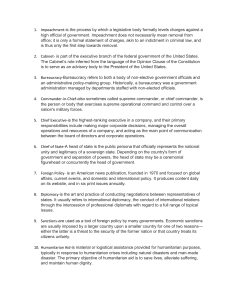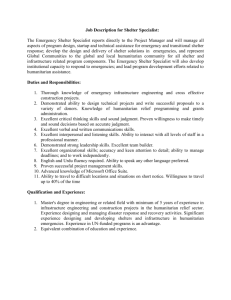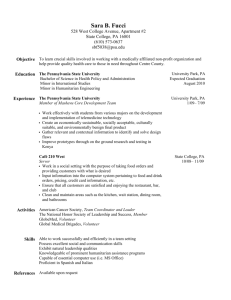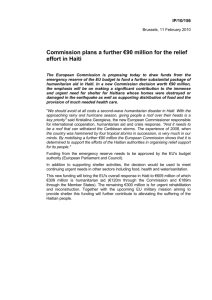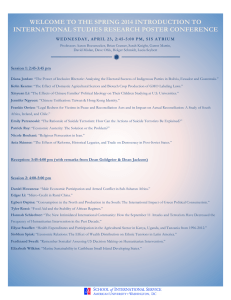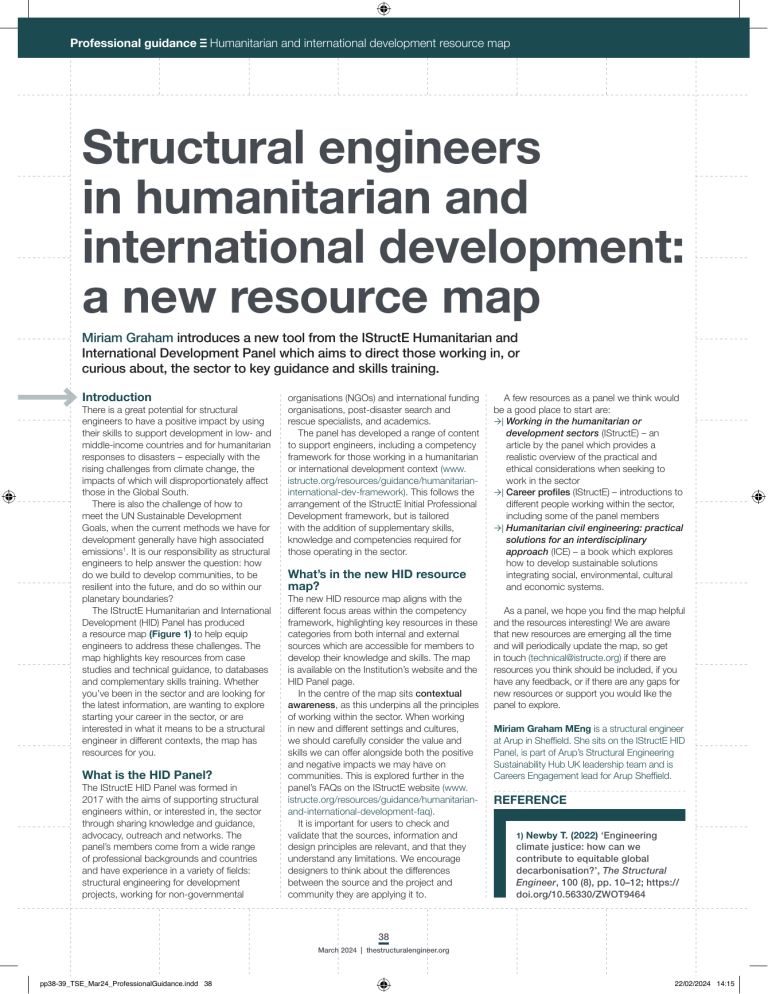
Professional guidance Humanitarian and international development resource map Structural engineers in humanitarian and international development: a new resource map Miriam Graham introduces a new tool from the IStructE Humanitarian and International Development Panel which aims to direct those working in, or curious about, the sector to key guidance and skills training. Introduction There is a great potential for structural engineers to have a positive impact by using their skills to support development in low- and middle-income countries and for humanitarian responses to disasters – especially with the rising challenges from climate change, the i pacts o hich ill disproportionatel a ect those in the Global South. There is also the challenge of how to meet the UN Sustainable Development Goals, when the current methods we have for development generally have high associated emissions1. It is our responsibility as structural engineers to help answer the question: how do we build to develop communities, to be resilient into the future, and do so within our planetary boundaries? The IStructE Humanitarian and International Development (HID) Panel has produced a resource map (Figure 1) to help equip engineers to address these challenges. The map highlights key resources from case studies and technical guidance, to databases and complementary skills training. Whether you’ve been in the sector and are looking for the latest information, are wanting to explore starting your career in the sector, or are interested in what it means to be a structural engineer in di erent contexts the ap has resources for you. What is the HID Panel? The IStructE HID Panel was formed in 2017 with the aims of supporting structural engineers within, or interested in, the sector through sharing knowledge and guidance, advocacy, outreach and networks. The panel’s members come from a wide range of professional backgrounds and countries and ha e experience in a ariet o elds structural engineering for development projects, working for non-governmental organisations (NGOs) and international funding organisations, post-disaster search and rescue specialists, and academics. The panel has developed a range of content to support engineers, including a competency framework for those working in a humanitarian or international development context (www. istructe.org/resources/guidance/humanitarianinternational-dev-framework). This follows the arrangement of the IStructE Initial Professional Development framework, but is tailored with the addition of supplementary skills, knowledge and competencies required for those operating in the sector. What’s in the new HID resource map? The new HID resource map aligns with the di erent ocus areas ithin the co petenc framework, highlighting key resources in these categories from both internal and external sources which are accessible for members to develop their knowledge and skills. The map is available on the Institution’s website and the HID Panel page. In the centre of the map sits contextual awareness, as this underpins all the principles of working within the sector. When working in ne and di erent settings and cultures we should carefully consider the value and skills e can o er alongside both the positi e and negative impacts we may have on communities. This is explored further in the panel’s FAQs on the IStructE website (www. istructe.org/resources/guidance/humanitarianand-international-development-faq). It is important for users to check and validate that the sources, information and design principles are relevant, and that they understand any limitations. We encourage designers to think about the di erences between the source and the project and community they are applying it to. A few resources as a panel we think would be a good place to start are: | Working in the humanitarian or development sectors (IStructE) – an article by the panel which provides a realistic overview of the practical and ethical considerations when seeking to work in the sector | areer profiles (IStructE) – introductions to di erent people orking ithin the sector including some of the panel members | Humanitarian civil engineering: practical solutions for an interdisciplinary approach (ICE) – a book which explores how to develop sustainable solutions integrating social, environmental, cultural and economic systems. s a panel e hope ou nd the ap help ul and the resources interesting! We are aware that new resources are emerging all the time and will periodically update the map, so get in touch (technical@istructe.org) if there are resources you think should be included, if you have any feedback, or if there are any gaps for new resources or support you would like the panel to explore. Miriam Graham MEng is a structural engineer at rup in he eld he sits on the truct Panel, is part of Arup’s Structural Engineering Sustainability Hub UK leadership team and is areers ngage ent lead or rup he eld REFERENCE 1) Newby T. (2022) ‘Engineering climate justice: how can we contribute to equitable global decarbonisation?’, The Structural Engineer, 100 (8), pp. 10–12; https:// doi.org/10.56330/ZWOT9464 38 March 2024 | thestructuralengineer.org pp38-39_TSE_Mar24_ProfessionalGuidance.indd 38 22/02/2024 14:15 Longer Reads Development and humanitarian concepts and practices Websites CARE Emergency Toolkit Shelter self-recovery CCCM cluster (Camp Coordination and Camp Management) Short Reads Settlements approaches in urban areas (Global Longer Reads Shelter Cluster) 2022 State of Humanitarian shelter, camp and settlement guidelines Systems reportUNHCR (ALNAP) (UNHCR) The State of the Humanitarian System report assesses the size, shape and performance of the humanitarian system against key criteria over time. It is Engineering in Emergencies (RedR) crisisindependent and based on evidence from on-the-ground practitioners, affected populations, academics, policy-makers and donors. 2022 State of Humanitarian Systems report (ALNAP) The State of the Humanitarian System report assesses the size, shape and performance of the humanitarian system against key criteria over time. It is independent and based on evidence from on-the-ground practitioners, crisisaffected populations, academics, policy-makers and donors. Integrating Housing, Land and Property Issues into Key Humanitarian, Transitional and Development Planning Processes (International Organization for Migration) Websites 9. Management and Training Short Reads Longer Reads Websites Humanitarian CivilHumanitarian Engineering: Standards Career Profiles Websites Websites Standards Humanitarian Career Development Profilesand humanitarian concepts and practices Websites CARE Emergency Toolkit This book allows you to understand the Alliance (CHS Alliance) significance of humanitarian civil engineering and how to develop sustainable solutions that Short Reads integrate social, environmental, cultural, and Websites Career Profiles (IStructE) Longer Reads Short Reads Video This article provides a realistic overview of the practical and ethical considerations when seeking to work in the sector. Video Longer Reads Humanitarian Civil Engineering: Practical solutions for an interdisciplinary approach (ICE) This book allows you to understand the significance of humanitarian civil engineering and how to develop sustainable solutions that integrate social, environmental, cultural, and economic systems. The Sphere Handbook (Sphere) Websites 2. Communication 3. Concept creation and design3. Concept creation and design 4. Analysis and sizing 4. Analysis and sizing Longer Reads The Shelter Compendium (Global Shelter Cluster) Websites The Shelter Compendium (Global Shelter Cluster) Is a database in reviewed Information, Education, and Communication (IEC) materials to support faster development of common technical messaging in crisis responses for shelter and settlements. Humanitarian and international development competencies framework (IStructE) This article provides a realistic overview of Global Shelter Cluster the practical and ethical considerations when seeking to work in the sector. Humanitarian and international development competencies framework (IStructE) This framework, developed by the Institution’s Humanitarian and International Development Panel, is designed to illustrate the types of skills that structural engineers will require to be successful in the development sector. economic systems. The Grand Bargain (IASC) or Working in the humanitarian Working in the humanitarian or The Sphere Handbook (Sphere) sectors (IStructE) development sectors (IStructE)Goals (UN) development UN Sustainable Development Websites Short Reads Partnership Practical solutionsPartnership for an Career Profiles (IStructE) interdisciplinary approach (ICE) Core Humanitarian Standards Core Humanitarian Standards Global(CHS agendas Alliance Alliance) and frameworks Shelter self-recovery Global agendas and frameworks Websites Longer Reads CCCM cluster (Camp Coordination The (IASC) andGrand CampBargain Management) UN Sustainable Development Goals (UN) Global Shelter Cluster Pinheiro Principles 2005 (Shelter Cluster) Settlements approaches in urban areas (Global Shelter Cluster) UNHCR shelter, camp and settlement guidelines (UNHCR) Engineering in Emergencies (RedR) This framework, developed by the Institution’s Humanitarian and International Development Panel, is designed to illustrate the types of skills that structural engineers will require to be successful in the development sector. Is a database in reviewed Information, Education, and Communication (IEC) materials to support faster development of common technical messaging in crisis responses for shelter and settlements. 2. Communication 11. Other resources standards and 1. Professional standards and 1. Professional engineering responsibility engineering responsibility Websites When working in different countries and contexts it When is important working to in check different and countries validate that andthe contexts sources, it isinformation important to check and validate that the sources, information and design principles still apply. It is helpful to thinkand about design the differences principles still from apply. whatItyou is helpful are reading to think and about the the differences from what you are reading and the project you are working on. The resources below explore projectthis youconcept are working in more on.depth. The resources below explore this concept in more depth. Contextual awareness and appropriate Contextual interventions awareness and appropriate interventions 10. Commercial and legal 11. Other resources Integrating Housing, Land and Property Issues into Key Humanitarian, Transitional and Development Planning Processes (International Organization for Migration) 10. Commercial and legal 9. Management and Training Websites Disaster Ready - free, online humanitarian and development training (Disaster Ready) Over 1,500 Resources for Humanitarian Aid and Development Professionals 39 Humanitarian Leadership Academy Short Reads thestructuralengineer.org | March 2024 Wattle & DaubTimber and Bamboo A vernacular-improved affordable, sustainable, and seismically-resilient bamboo housing Longer Reads Videos Timber and Bamboo Videos Humanitarian Bamboo Guidelines (Humanitarian Bamboo) Wattle & Daub Longer Reads Wattle & Daub: Anti-seismic construction Handbook (CRATerre-EAG) Design Guide for Engineered Bahareque Housing (INBAR) Modern engineered wattle and daub Zoom in to click the links and use Ctrl+F to search Humanitarian Bamboo Guidelines (Humanitarian Bamboo) technology for technology for Design Guide for Engineered Latin America and beyond.Longer Reads Latin America and beyond. Bahareque Housing (INBAR) How to Build Safer Houses with wattle and daub Modern engineered Short Reads Confined Masonry (Practical Short Reads Action) 11 recommended reads on using 11 recommended reads on using book on confined masonry and detailing timber and bambooShort (IStructE) timber and bamboo (IStructE) Constructing Low-rise Confined Longer Reads Masonry Buildings Longer Reads Book on low-rise confined masonry Timber as a construction material Timber as a construction material in humanitarian operations in humanitarian operations (UNOCHA-IFRC-CARE) (UNOCHA-IFRC-CARE) A vernacular-improved affordable, sustainable, and seismically-resilient bamboo housing Masonry 5. Materials Sustainable bamboo housing (IStructE) Sustainable bamboo housing Wattle & Daub: Anti-seismic (IStructE) construction Handbook (CRATerre-EAG) This case study examines assessing and improving the wind resistance of bamboo This emergency case study shelters examines in the assessing Rohingya refugee and improving camps.the wind resistance of bamboo emergency shelters in the Rohingya refugee camps. 5. Materials 6. Sustainability Longer Reads Masonry Lessons from Aceh: Shelter Key Startingprofiles from 11mins: Lessons from Aceh: Key Starting from 11mins: The New Humanitarian The New Humanitarian Shelter response profiles response considerations in postconsiderations in postAppropriate structural (CRAterre) (CRAterre) Appropriate structural Commisceo Global Commisceo Global Country- or region-specific information on Country- or region-specific information on disaster reconstruction disaster reconstruction engineering in humanitarian engineering in humanitarian Local culture, customs and etiquette Local culture, customs and etiquette shelter typologies (Arup and Disasters shelter typologies and international development (Arup and Disasters Websites and international development Websites Websites OCHA Humanitarian Response OCHA Humanitarian Response Emergency Committee) contexts (UCL / Arup) Emergency Committee) contexts (UCL / Arup) Putting People at the Centre of Putting People at the Centre of ThinkHazard (World Bank GFDRR) ThinkHazard (World Bank GFDRR) Disaster Ready - free, online Building Back Better: Delivering Building Back Better: Delivering Reconstruction (Practical Action) Shelter After Disaster Shelter After Disaster humanitarian and development Reconstruction (Practical Action) people-centred housing people-centred housing Longer Reads Longer Reads (IFRC and OCHA) (IFRC and OCHA) training (Disaster Ready) Community engagement in Community engagement in reconstruction at scale reconstruction at scale Over 1,500 Resources for Humanitarian Aid and REDi rating (Arup) REDi rating (Arup) disaster response: 2015 Gorkha, disaster response: 2015 Gorkha, Development Professionals Humanitarian and international Humanitarian and international Nepal (IStructE) Short Reads Short Reads Kaya - free, online humanitarian Nepal (IStructE) development: FAQs development: FAQs training (Kaya) Is rigorous structural engineering possible in a humanitarian Is rigorous context?structural (IStructE)engineering possible in a humanitarian context? (IStructE) 7. Construction & 6. Sustainability 8. Health, safety and risk management Short Reads Longer Reads RICA – climate-positive design using locally sourced materials RICA(IStructE) – climate-positive design using locally sourced materials (IStructE) Howof to This article describes the climate-positive design for the campus of the Rwanda Institute This article describes the climate-positive design for the campus the Build RwandaSafer InstituteHouses with for Websites Conservation Agriculture. for Conservation Agriculture. Confined Masonry (Practical Action) to equitable global RedR Engineering climate justice: how can we contribute to equitable Engineering globalclimate justice: how can we contribute Short book on confined masonry and detailing decarbonisation? (IStructE) decarbonisation? (IStructE) Hostile Environment Awareness Training A personal perspective A personal perspective Constructing Low-rise Confined Longer Reads engineers contribute towards disaster How Masonry Buildings How can structural mitigation? can structural (IStructE) engineers contribute towards disaster mitigation? (IStructE) Book on low-rise confined masonry In his Kenneth Severn 2013 Award-winning paper, Joshua Macabuag advocates the In his adoption Kenneth of Severn a systems 2013 Award-winning paper, Joshua Macabuag advocates the adoption of a systems GSC Construction Good Practices approach to the delivery of resilient buildings and infrastructure. approach to the delivery of resilient buildings and infrastructure. (Global Shelter Cluster) Greening Shelter Response (Global Shelter Cluster (GSC))Greening Shelter Response (Global Shelter Cluster (GSC)) Longer Reads Building Materials and The Climate: constructing a new future Building Materials and The Climate: constructing a new future Outlines principles to reduce environmental impact of construction and transition Outlines to principles to reduce environmental impact of construction and transition to low carbon construction in a global context low carbon construction in a global context Nature-based solutions for climate resilience in humanitarian Nature-based action (Sphere) solutions for climate resilience in humanitarian action (Sphere) Zoom in to click the links and use Ctrl+F to search 22/02/2024 14:15 pp38-39_TSE_Mar24_ProfessionalGuidance.indd 39 Kaya - free, online humanitarian training (Kaya) Humanitarian Leadership Academy Websites 7. Construction & 8. Health, safety and risk management RedR Hostile Environment Awareness Training Please Note: These resources are highlighted to the reader for their potential value/interest. Further resources are available via the IStructE Humanitarian and International Development Panel webpage, as well as new resources published since the last update to the resource map. Some have been produced by third parties. The Institution of Structural Engineers does not necessarily endorse (nor is it responsible for) any statement or opinion expressed within these. GSC Construction Good Practices (Global Shelter Cluster) Longer Reads The new humanitarian and international development resource map is an interactive guide to key resources in the sector. Explore the map at: www.istructe.org/resources/guidance/hid-resource-map Access the resource map Short Reads Humanitarian and International Development resource map Please Note: These resources are highlighted to the reader for their potential value/interest. Further resources are available via the IStructE Humanitarian and International Development Panel webpage, as well as new resources published since the last update to the resource map. Some have been produced by third parties. The Institution of Structural Engineers does not necessarily endorse (nor is it responsible for) any statement or opinion expressed within these. ÔFIGURE 1: Interactive HID resource map highlights key resources for those working in a humanitarian or international development context Professional guidance Humanitarian and international development resource map Reads Housing, Land, and Property Housing, Land,Longer and Property in Shelter Programs (Cornerstone OnDemand Foundation)in Shelter Programs (Cornerstone OnDemand Pinheiro Principles 2005 (ShelterFoundation) Cluster) Humanitarian and International Development resource map
